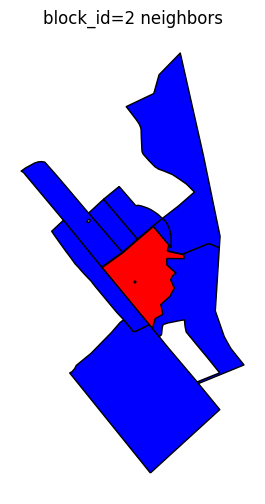Adjacency relations
[16]:
import pandas as pd
blocks_gdf = pd.read_pickle('./../data/saint_petersburg/blocks.pickle')
blocks_gdf.head(3)
[16]:
| geometry | site_area | residential | business | recreation | industrial | transport | special | agriculture | land_use | ... | capacity_prison | count_prison | capacity_landfill | count_landfill | capacity_plant_nursery | count_plant_nursery | capacity_greenhouse_complex | count_greenhouse_complex | capacity_warehouse | count_warehouse | |
|---|---|---|---|---|---|---|---|---|---|---|---|---|---|---|---|---|---|---|---|---|---|
| 0 | POLYGON ((349424.859 6631180.891, 349424.751 6... | 0.032316 | 0.000 | 0.0 | 0.000000 | 0.0 | 1.000000 | 0.0 | 0.000000 | LandUse.TRANSPORT | ... | 0.0 | 0.0 | 0.0 | 0.0 | 0.0 | 0.0 | 0.0 | 0.0 | 0.0 | 0.0 |
| 1 | POLYGON ((352083.617 6633950.146, 352240.448 6... | 137101.088247 | 0.099 | 0.0 | 0.079912 | 0.0 | 0.401072 | 0.0 | 0.417018 | LandUse.AGRICULTURE | ... | 0.0 | 0.0 | 0.0 | 0.0 | 0.0 | 0.0 | 0.0 | 0.0 | 0.0 | 0.0 |
| 2 | POLYGON ((346700.642 6618453.176, 346681.107 6... | 95239.084434 | 1.000 | 0.0 | 0.000000 | 0.0 | 0.000000 | 0.0 | 0.000000 | LandUse.RESIDENTIAL | ... | 0.0 | 0.0 | 0.0 | 0.0 | 0.0 | 0.0 | 0.0 | 0.0 | 0.0 | 0.0 |
3 rows × 137 columns
Adjacency graph
Generate adjacency graph indicating relations between adjacent blocks.
[2]:
from blocksnet.relations import generate_adjacency_graph
adjacency_graph = generate_adjacency_graph(blocks_gdf, 10)
2025-09-19 19:37:40.874 | INFO | blocksnet.relations.adjacency.core:_generate_adjacency_nodes:9 - Generating nodes
2025-09-19 19:37:40.880 | INFO | blocksnet.relations.adjacency.core:_generate_adjacency_edges:14 - Generating edges
2025-09-19 19:37:43.924 | SUCCESS | blocksnet.relations.adjacency.core:generate_adjacency_graph:37 - Adjacency graph successfully generated: 9533 nodes, 30567 edges
Now adjacency_graph is a networkx.Graph instance and can be operated using its methods. For example, one can get block_id=2 neighbors using g.neighbors(2).
[4]:
block_id = 2
neighbors = adjacency_graph.neighbors(block_id)
block_gdf = blocks_gdf.loc[[block_id]]
neighbors_gdf = blocks_gdf.loc[neighbors]
ax = block_gdf.plot(color='red', figsize=(6,6), edgecolor='black')
neighbors_gdf.plot(ax=ax, color='blue', edgecolor='black')
ax.set_title(f'block_id={block_id} neighbors')
ax.set_axis_off()

Adjacency context
Get adjacency graph’s subgraph for blocks provided.
[10]:
from blocksnet.relations import get_adjacency_context
context_graph = get_adjacency_context(adjacency_graph, block_gdf)
len(context_graph.nodes), len(context_graph.edges)
[10]:
(9, 17)